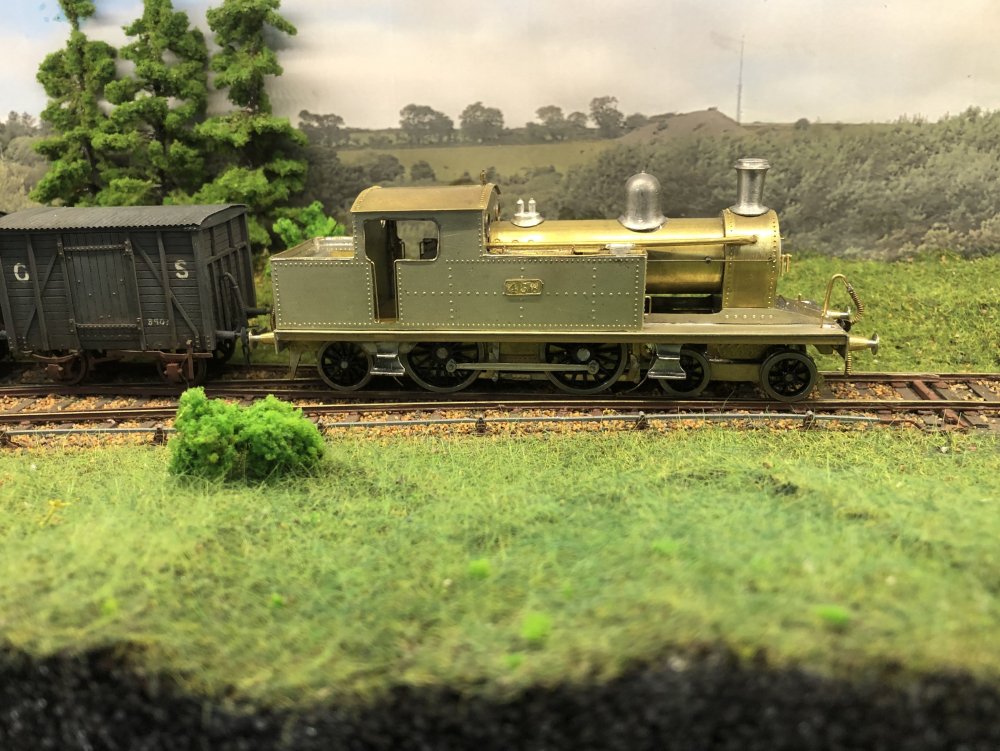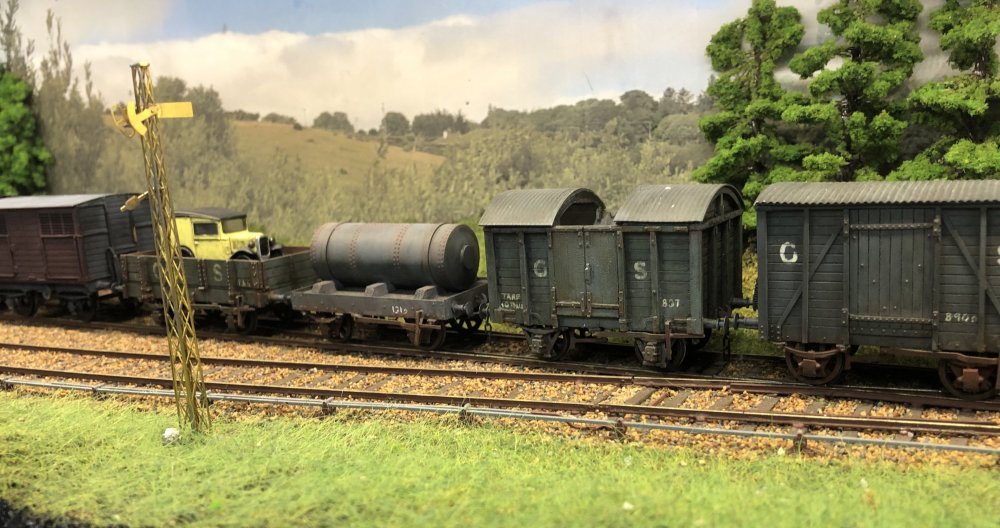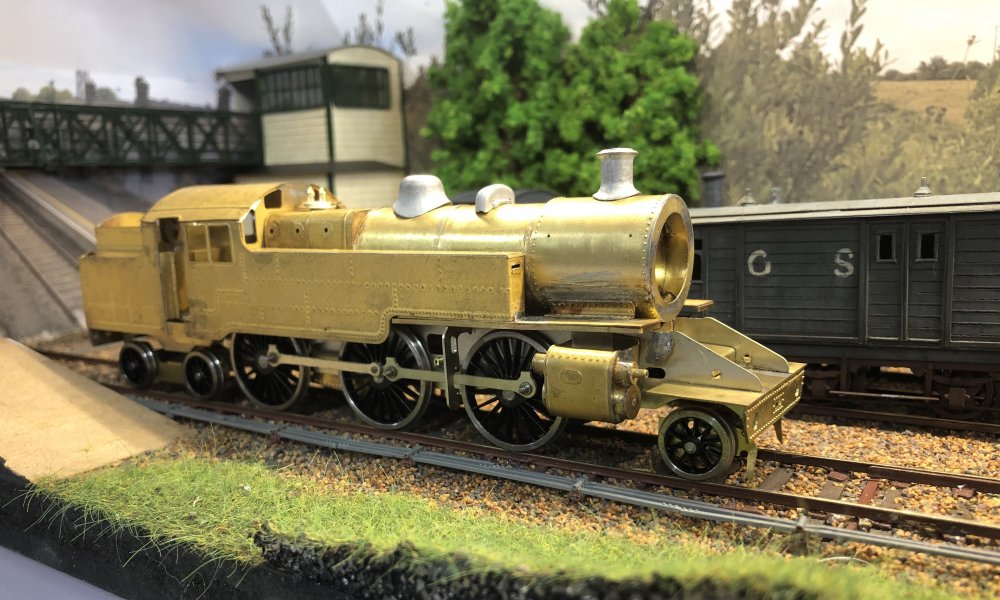-
Posts
15,930 -
Joined
-
Last visited
-
Days Won
394
Content Type
Profiles
Forums
Events
Gallery
Blogs
Community Map
Everything posted by jhb171achill
-
Yes. It will come as a relief for our younger readers to know that while latterly these locos almost inevitably ran in pairs, either with other 121s, or with 141s or 181s, initially they didn't, and I am personally unaware of ANY instance of a pair in grey, or even a grey one paired with anything else. It was really only in the early 70s that pairing became regular. In initial times, i.e. when they were grey, a certain amount of nose-first running happened, but with turntables still a-plenty, they were able to turn them for return journeys almost anywhere. As mentioned above, when introduced most passenger stock was still green, and you'll see pics of many a grey one with only green or (VERY dirty) silver vehicles behind them. Silver TPOs and "tin vans" of both heating and luggage variety did not all get the green livery - some did, some didn't; so both are appropriate to the 121-grey period. Naturally, these started being repainted black'n'tan soon after. As mentioned above, a couple of grey 121s got red buffer beams, but I am not entirely sure that they were repainted grey too - I suspect that the red was just added. In terms of WHEN repaints into black'n'tan took place, by 1964 some are in this livery - that's a very short time in traffic for the initial paint scheme. On the other hand, at least one was still grey in 1967. For modellers of the period when the 121s were delivered, there are a lot of livery variations, and it's possible to stock a layout for that period prototypically with items of which hardly two are the same colour scheme. 121s - grey, with or without red buffer beams. Let's say we're doing 1961-65; black'n'tan too. 141s - black'n'tan, with no CIE "roundels" until late 60s. 181s - black'n'tan with roundels from new "E" class - some black with white flash, some black'n'tan "G601" - green or black with white flash "G611" - never green (despite preservation and some models!), but either black with white, or black'n'tan "B113" - green, then black'n'full tan, then black with yellow end panels. "B101" - None still silver, but either green, black with white flashes, or a unique livery which had full tan sides, but white line at the top on ENDS only. I'm pretty sure none got the yellow panel. "C" - one or two still quite exceptionally filthy former silver. Most green, and all being gradually being repainted either black'n'tan (not many), black with white end flash, or same with yellow panel. "A" - as per the "C"s above, but with several variations of side markings: some black ones had a large number on the side, as the ITG's A38 had in its last livery; or a CIE logo there, but with smaller loco numbers under the cab at each end. Carriages - a handful still dirty silver, the majority green, but black'n'tan probably overtaking them numerically by 1965/6. One or two ex-GN types still were knocking about in either GNR brown or GNR dark blue and cream; one brown one did a stint in West Cork just before that system closed! Wagons - everything grey. The brown livery was almost a decade away. Technically, the corrugated opens were the same "silver", but with grey-painted frames; they would never (in single-deck version) have painted bodies at all until they were doubled for beet 25 years later. Goods brake vans are just beginning to get the yellow and black "zebra stripes" on their duckets. Older wooden wagons and vans at this stage are becoming very weathered. If modelling Northern Ireland, under the UTA they were so worn that proper identification of any actual "livery" was often all but impossible; just cover with weathering! Cement bubbles were without exception grey when introduced, although the last ones built about 1969/70 or so entered traffic in orange, with grey chassis; peculiarly, the initial grey ones, unusually for ANY goods stock in Ireland, had a black chassis, as seen on the IRM model. Cravens were black'n'tan from new, and retained the same livery into the early 1990s. Thus, historically, the single-white-line Cravens are the only show in town for anything in the CIE era (up to 1987), and for a short time afterwards. Thus, no grey, green, silver black'n'tan loco ever ran with Cravens with the two white lines. (The first Craven I ever saw with the orange line above, and two white lines, was in May 1989, and it looked very newly painted). Phew! Hope that helps.
-
CIE locomotive livery variations 1960-1990
jhb171achill replied to jhb171achill's question in Questions & Answers
Technically, the top one (088) is incorrect in details. First, as on the "heritage" 071 at the moment, the CIE roundel, while all-white, wasn't the standard CIE transfer on the factory-delivered 071s. When delivered, the all-white CIE logo was not the correct design, with a larger diameter perimeter and non-standard lettering. The design of the logo on the model of 088, and the "heritage" (I nearly said "preserved"!) 071 is the standard one, though they've got the non-standard "all-white" bit correct. Secondly, I am not sure if the running plate was orange - I stand to be corrected on this, but I think it was black. As implied above, the red brake handle came later. The BIG thing, though, was the colour. General Motors appear to have simply got this wrong, and by some margin. The orange on the model is right for what OTHER locos (and carriages) had at the time. The slightly brighter shade would appear during the 1980s. On first repaint, all 071s got the then-standard orange as above, along with CIE badges of the standard style, and with orange "broken wheels". Hope this helps! As far as I recall, I have yet to see in model form the "correct, "incorrect" shade" that they were delivered in. It was distinctly brownish, and much more worthy of the description of "golden brown" than the original shade was in 1962. -
Mostly open wagons of coal from the quayside - ideal for a shunting-type layout. Also goods vans of ex-NCC and GNR origin, and of course one or two NCC “brown vans”. All loose-coupled, so a goods brake van obligatory.
-
Sligo, Leitrim and Northern Counties Railway
jhb171achill replied to Colin R's topic in General Chat
Strangely, the border was an advantage, as most of the funding was coming from the cross-border “peace” funding from IFI & ERDF. Had it not been cross-border, it wouldn’t have qualified. Brexit could, of course, have presented problems had it come to be, and a “hard border” would probably kill it. Regarding Suir Valley type schemes, in a country with a market the size of ours, this would sadly be more sustainable financially. -
Sligo, Leitrim and Northern Counties Railway
jhb171achill replied to Colin R's topic in General Chat
The principal enthusiast end of it was coming from the Enniskillen end at that time! It was deliberately designed to be operable with the smallest possible number of people. It would be branded as a vintage diesel line, in keeping with the fact that almost all passenger services from the 1940s were peculiar, pioneering, and / or unique railcars. The line proceeded across the river and agreement had been obtained from the British Army (who had blown the bridge up) to rebuild it. The lakeside terminus was a simple platform with a lock-up ticket hut; to prevent vandalism, a waiting room would be provided on operating days by a six-wheeled coach parked there (an idea later adopted by the DCDR at Inch Abbey). In Belcoo, agreement had been reached with the owners of the restored station and signal cabin, but as an initial stage the railcar would stop just short of the station to avoid reinstating the level crossing. A one-railcar-length platform was to be provided there, with the adjacent community centre selling tickets and providing car parking and toilets. One landowner objected; the middle one out of five. Once he had been visited and talked round, one at the Belcoo end, on whose land a maintenance shed & museum would have had to have been built - HE now objected. He dug his heels in; a couple of years passed, and the funding expired. Turned out that these two had local “history”, and anything that one approved of, the other would childishly get “over-sensitive” about, and object to from then on, as a “principle”! Ho hummmm! The one that got away. -
General Motors GM6 six-wheeled locomotive similar to a 121
jhb171achill replied to jhb171achill's topic in General Chat
Superb, NIR, good detective work! I remain fascinated by these six-wheel things.... The “E121” class, perhaps! -
Sligo, Leitrim and Northern Counties Railway
jhb171achill replied to Colin R's topic in General Chat
Such a thing WAS actually planned, and got past the first approval of funding stage, about 25 years ago! It would have been a small, but very fantastic line about 2km long, from the shore of Lough Macnean to Belcoo station. For economy, no steam was planned, but approval had been gained to run Railcar "B" (before it ever was scheduled to go to Downpatrick), a "G" class with 2 Midland 6-wheelers (which did often operate on the line when the SLNCR was short of stock), and the ex-NCC railcar No. 1 at Whitehead. The scheme foundered due to bickering between two of the local landowners over whose lands it would pass. I still have the paperwork. "Lough Erne" would be placed, courtesy of a long-term loan by the RPSI, on display in the now-demolished goods shed as a static exhibit. -
Sligo, Leitrim and Northern Counties Railway
jhb171achill replied to Colin R's topic in General Chat
Jayyysus; one trump is enough! (........sorry, I'll get me coat.......!!) -
Absolutely inspirational historical detective work, RichL; I think I'm not the only one following this fascinating thread! Looking forward to seeing the results.
-
Yes, I believe she was withdrawn in 1963, though probably was stopped before that. Livery - in NCC times, unlined, plain black. In UTA times, the “roundel” device (she never got the later crest), with a red coupling rod and the attractive red and light beige UTA lining.
-
There were two. The NCC used them to shunt Belfast docks and York Road yard. They never did anything else, though they were trialled on Carrickfergus passenger trains. One lasted into the early 1960s.
-
That is one mighty layout he has....
-
Ah yes, I remember now - very superb work indeed!
-
That's 2mm? Wow - superb. Can we see the horse box and the van next to it?
-
Freelance Mixed Gauge - Handbuilt Trackwork
jhb171achill replied to RichL's topic in Irish Model Layouts
Very many thanks, Edo! There ye go then...... My Dugort harbour (currently in Baseboard Dave's) has one too! Given that the fictitious "prototype" of this place would have been very much built on the cheap, space-saving would be as important as in my attic! -
Freelance Mixed Gauge - Handbuilt Trackwork
jhb171achill replied to RichL's topic in Irish Model Layouts
Indeed, Edo - I had forgotten about that one. I think there was one somewhere in Wisht Caark too.... as I said earlier, I cannot remember but I've a note of it SOMEwhere........... -
Wow! Yet another thing of beauty from the Land of Holman! And you're right - in terms of appearance a yoke like that would be weathered and worn within an inch of its life!
-
That's the hedge outside cut back for another year!
-
Freelance Mixed Gauge - Handbuilt Trackwork
jhb171achill replied to RichL's topic in Irish Model Layouts
You mean three-way points? Yes, there were - but they were very rare indeed. I am unaware of any in existence either now, or anywhere in the last forty years anyway. I think there were two at Polloxfen's sidings at Ballysodare - certainly one anyway. There was another somewhere else, the location of which now escapes my mind. -
Looks absolutely O U T S T A N D I N G !!!
-
Having seen this in the flesh for the first time in Bray this morning, I can say that it looks even better in real life - a true masterpiece! Very nice to meet Ken as well! I took these this morning.....
-
There’s been part un, part deux...... Part trois? Well........let’s wait’n’see!!
-
When the “supertrain” branding first came in (1972), only a handful of engines had the “supertrain” livery at first, whereas the new air-conditioned stock had it from new. Thus, black’n’tan locos hauling ST carriages was very much a feature for maybe 2 years until most locos were repainted. From recollection, the “A” class seemed to be mostly in the new livery long before the 121, 141 & 181 class were.
.png.c363cdf5c3fb7955cd92a55eb6dbbae0.png)







